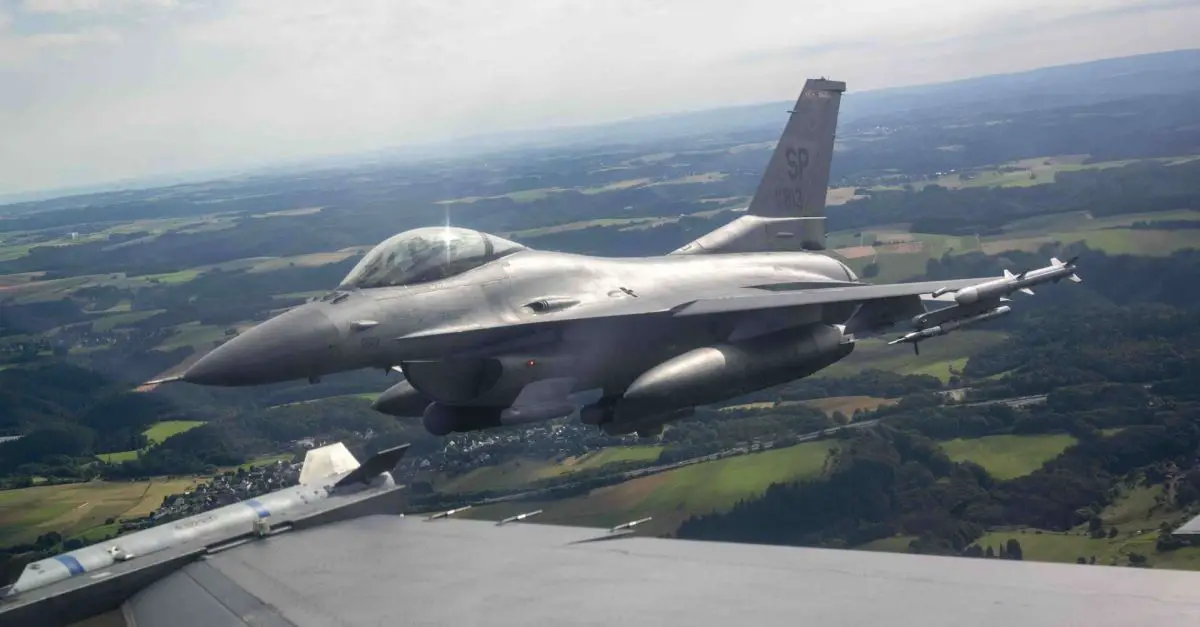Breaking News
News Analysis: Threats Faced by US F-16 Fighter Aircraft in Ukraine from Russia.
As Ukraine receives US F-16 fighter aircraft, the capabilities of these versatile jets are put to the test against Russia's military technology. The F-16, renowned for its adaptability and success in various combat scenarios, encounters significant threats from Russia’s sophisticated air defense systems and other military combat equipment. This analysis explores the diverse array of Russian military technologies that threaten the operational effectiveness of the F-16, shedding light on the strategic challenges that Ukrainian forces must navigate in this high-stakes theater of war.
Follow Army Recognition on Google News at this link

U.S. Air Force F-16 Fighting Falcon fighter flies over Germany on June 28, 2024. (Picture source: U.S. DoD)
The U.S. F-16, known for its versatility and adaptability in a wide range of combat scenarios, is significantly threatened by Russia's advanced air defense systems. One of the most formidable among these is the S-400 Triumf, a long-range surface-to-air missile system. The S-400 is designed to engage a variety of aerial threats, including aircraft, unmanned aerial vehicles (UAVs), and even ballistic missiles, at ranges of up to 400 kilometers. Its advanced radar capabilities allow it to track multiple targets simultaneously, including those employing stealth technology or flying at low altitudes, making it particularly dangerous for the F-16.
Beyond the S-400, the newer S-500 Prometheus system poses an even greater challenge. The S-500 is equipped to intercept hypersonic missiles and stealth aircraft at extended ranges and altitudes, which further complicates the operational environment for F-16 pilots. Additionally, the Pantsir-S1, a combined short to medium-range air defense system, provides close-range protection to these advanced systems. It can effectively engage low-flying aircraft during close air support missions, putting F-16s at risk during such operations.
Electronic Warfare Capabilities
Russia's electronic warfare (EW) capabilities present another significant threat to the F-16. Systems like the Krasukha-4 are designed to jam and disrupt enemy radar and satellite communications. This EW system can blind the F-16's radar and navigation systems, making it challenging for pilots to maintain situational awareness and target acquisition. Such disruption not only affects the operational efficiency of the aircraft but can also lead to mission failure.
Another EW system, the Murmansk-BN, is capable of disrupting communications over vast distances, further complicating the F-16's ability to coordinate with other units and command centers. By interfering with communication lines, this system can isolate F-16 squadrons, making them more vulnerable to Russian defenses and reducing their combat effectiveness.
Russian Fighter Aircraft
In addition to air defense systems and electronic warfare, Russian fighter aircraft pose a direct threat to the F-16 in air-to-air combat scenarios. The Sukhoi Su-35 is one of Russia's most advanced multirole fighters, boasting superior maneuverability and state-of-the-art avionics. Equipped with thrust-vectoring engines and advanced radar systems, the Su-35 can potentially outmaneuver and detect F-16s before they are aware of its presence, providing a substantial combat advantage.
Similarly, the Mikoyan MiG-31, a long-range interceptor, is designed to engage targets at high speeds and altitudes. The MiG-31's capabilities enable it to confront F-16s in conditions where evasion is particularly challenging. The **Sukhoi Su-57**, Russia's cutting-edge stealth multirole fighter, is another formidable adversary. With its stealth features and advanced avionics, the Su-57 can detect and engage F-16s in contested airspace, challenging their operational capabilities and survival.

The Pantsir-S1 air defense system threatens Ukrainian F-16s by effectively targeting low-flying aircraft with missiles and anti-aircraft guns. (Russian MoD)
Missile Technology
Russian missile technology represents a critical threat to the F-16, both in air-to-air and ground-to-air combat situations. The R-77 (AA-12 Adder) is an advanced medium-range air-to-air missile that employs active radar homing. Capable of engaging targets at ranges up to 100 kilometers, the R-77 allows Russian aircraft to strike F-16s from a distance, posing a significant threat in aerial engagements.
The R-37M long-range air-to-air missile, designed to target high-value assets like AWACS, extends this threat even further. With a range of up to 400 kilometers, it can threaten F-16s operating at considerable distances from their launch platforms. Additionally, Kalibr cruise missiles, known for their precision and long-range capabilities, can target airbases and logistical support systems, undermining the F-16's operational effectiveness by attacking its ground support infrastructure.
Radar and Sensor Technology
The F-16 also faces challenges from Russia's advancements in radar and sensor technology, which can compromise its stealth and detection capabilities. The Nebo-M radar system, a mobile, multi-band radar, is capable of tracking stealth aircraft. Its ability to detect and track low-observable targets challenges the F-16's capacity to operate undetected in hostile environments.
Additionally, the Zaslon-M radar, used in MiG-31 interceptors, is an advanced phased-array system capable of engaging multiple targets at extended ranges. This capability makes it difficult for F-16s to evade detection and tracking, reducing their operational effectiveness and survivability in contested airspace.
In conclusion, the F-16 faces a multifaceted array of threats from Russian military equipment, encompassing advanced air defense systems, sophisticated electronic warfare capabilities, modern fighter jets, and cutting-edge missile and radar technology. To counter these threats, it is crucial for F-16 operators to continue investing in technological upgrades, such as advanced electronic countermeasures, stealth enhancements, and improved missile systems. Additionally, effective integration with allied forces and leveraging intelligence and surveillance assets will be essential to maintain an operational advantage in increasingly contested environments.


























